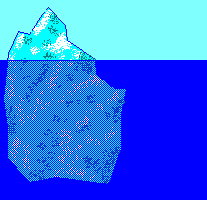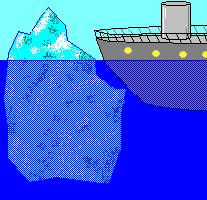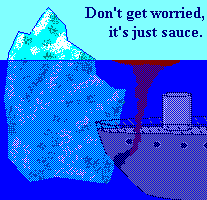Isostasy
Let's take a field trip back to ancient Greece, about 2200 years ago. There lived a man whose name was Archimedes, and he was a scientist and mathematician. One day the king came to him with a troubling problem. He gave gold to a craftsman to build a crown, but the craftsman may have stolen some of the gold and used a less expensive metal for part of the crown. It was Archimedes job to find out if the crown was real gold.
 This was tough. Archimedes couldn't cut or damage the crown in any way, but he had to determine what was inside it. He pondered this problem while he went to take his bath.
This was tough. Archimedes couldn't cut or damage the crown in any way, but he had to determine what was inside it. He pondered this problem while he went to take his bath.
As he climbed into the tub, he noticed that water sloshed out of the tub and onto the floor. Messy. But as he stepped in, the water rose, and as he stepped out, the water went back down. He noticed that the water rose or fell depending on the density of the object placed in it. He figured out that if two objects had the same weight, the more dense object will displace less water. He was so excited he jumped out of the bath and ran through the street yelling "Eureka," which is Greek for "I found it." (And no, he wasn't yelling about finding the soap.)
By the way, the crown wasn't gold. Silver had been substituted. To get the whole story read more about it.
Two forces are at work when an object is placed in water. The first is very familiar - gravity. Gravity is pulling the object down through the water. Another force is working to keep the object up. The water is exerting a force on the object, and we call that force buoyancy.
Let's use an iceberg as an example. Most of the iceberg is under water, but ice is less dense than water, so it will float. The forces at work are gravity and buoyancy. Move the mouse over the picture to see these forces illustrated.
When these forces are balanced, we have ISOSTASY. Isostasy is just a balance between the forces pushing down and the forces pushing up.
Let's keep this iceberg around for a minute. Imagine it floating in the North Atlantic when a big ship pulls up to it. Let's call the ship the "H.M.S. Gigantic." The Gigantic pulls up to the iceberg and a couple get out for a picnic. Watch what happens to the iceberg when the couple step onto it. Move the mouse over the berg for a demonstration.
The iceberg sinks deeper into the water. There is more force pushing down on the iceberg now because there is more mass. The iceberg will sink until the forces pushing up (buoyancy) equal the forces pushing down (gravity). When isostasy is reached, the iceberg will be at rest.
To continue the story - The happy couple finish their picnic on the iceberg and return to the Gigantic. Late that night, the Gigantic hits the iceberg and sinks. The chef was preparing a big spaghetti festival for dinner with tons of marinara (tomato) sauce. As the boat sinks, the sauce drifts onto the ocean, making the waves rather tasty. The last words the chef spoke were, "I sauced a sea!"
OK, that was corny, but it was memorable. Perhaps if you see the word "isostasy" again (like on a test) it will bring back memories.
So what does this have to do with the earth? The earth's plates, its lithosphere, is floating on the liquid mantle. Just like the iceberg, the crust rises and falls depending on its density and mass.
Back to density,
back to earth layers or
all the way back to first or third term.

 This was tough. Archimedes couldn't cut or damage the crown in any way, but he had to determine what was inside it. He pondered this problem while he went to take his bath.
This was tough. Archimedes couldn't cut or damage the crown in any way, but he had to determine what was inside it. He pondered this problem while he went to take his bath.

